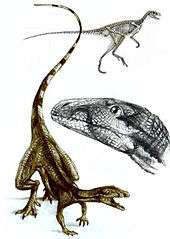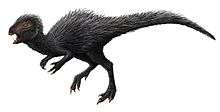Lagosuchus
Lagosuchus is a genus of small avemetatarsalian archosaur from the Middle to Late Triassic period. It is generally thought to be closely related to dinosaurs, as a member of the Dinosauromorpha. Its fossils were found in the Chañares Formation of Argentina, the dating of which is uncertain; some sources date it to the Middle Triassic whilst others date it to the earliest Carnian.
| Lagosuchus | |
|---|---|
 | |
| Mounted skeleton | |
| Scientific classification | |
| Kingdom: | Animalia |
| Phylum: | Chordata |
| Clade: | Dinosauromorpha |
| Clade: | Dinosauriformes |
| Order: | †Lagosuchia Paul, 1988 |
| Family: | †Lagosuchidae Bonaparte, 1975 |
| Genus: | †Lagosuchus Romer, 1971 |
| Species: | †L. talampayensis |
| Binomial name | |
| †Lagosuchus talampayensis Romer, 1971 | |
History
The type species Lagosuchus talampayensis was first described by Alfred S. Romer in 1971, who considered it a "pseudosuchian" (then a collection of various non-dinosaurian "thecodonts").[1] In 1972 he named a second species, Lagosuchus lilloensis, known from a larger and more well-preserved skeleton.[2] A later review by Jose Bonaparte in 1975 synonymized the two species and considered Lagosuchus intermediate between "pseudosuchians" and saurischian dinosaurs.[3]
Modern authors now consider at least L. lilloensis to be firmly on the lineage of archosaurs leading to dinosaurs.[4] However, the genus Lagosuchus is regarded by some to be dubious. Paul Sereno and Andrea Arcucci considered L. talampayensis to be undiagnosable in a 1994 study, and reclassified L. lilloensis as a new genus, Marasuchus.[5] In 2019, the holotype skeleton of L. talampayensis was redescribed by Federico Agnolin and Martin Ezcurra who determined it to not only be diagnostic, but indistinguishable from specimens of Marasuchus lilloensis, and so supported the synonymy proposed by Bonaparte.[6] Additionally, the dating of its formation is unclear; recent research has dated the Chañares to the early Carnian stage of the Late Triassic.[7]
Description

Lagosuchus is known from very incomplete remains (only a hind leg plus a shoulder blade and vertebrae can be definitely assigned to it). However, features of the leg show that it was a lightly built archosaur, and is notable for its long slender legs and well-developed feet - features it shares with certain dinosaurs. These features, as well as comparisons to close relatives, suggest that it could run on its hind legs for short periods, although it probably moved on all fours most of the time. Lagosuchus was likely an agile predator that could use speed to chase its prey and to escape larger predators.[8] Lagosuchus was about the size of a ferret.[9]
Palaeobiology
Metabolism
It is believed that Lagosuchus and Marasuchus were transitional between cold blooded reptiles and warm blooded dinosaurs.[10]
References
- Romer, Alfred Sherwood (15 June 1971). "The Chañares (Argentina) Triassic reptile fauna. X. Two new but incompletely known long-limbed pseudosuchians". Breviora. 378: 1–10.
- Romer, Alfred Sherwood (11 August 1972). "The Chañares (Argentina) Triassic reptile fauna. XV. Further remains of the thecodonts Lagerpeton and Lagosuchus". Breviora. 394: 1–7.
- Jose, Bonaparte (1975). "Nuevos materiales de Lagosuchus talampayensis Romer (Thecodontia-Pseudosuchia) y su significado en el origen de los Saurischia: Chañarense inferior, Triásico medio de Argentina" (PDF). Acta Geológica Lilloana. 13 (1): 5–90.
- Nesbitt, S.J. (2011). "The Early Evolution of Archosaurs: Relationships and the Origin of Major Clades" (PDF). Bulletin of the American Museum of Natural History. 352: 189. doi:10.1206/352.1. hdl:2246/6112. ISSN 0003-0090.
- Sereno, Paul C.; Arcucci, Andrea B. (March 1994). "Dinosaurian precursors from the Middle Triassic of Argentina: Marasuchus lilloensis, gen. nov". Journal of Vertebrate Paleontology. 14 (1): 53–73. doi:10.1080/02724634.1994.10011538.
- Agnolin, Federico L.; Ezcurra, Martin D. (2019). "THE VALIDITY OF LAGOSUCHUS TALAMPAYENSIS ROMER, 1971 (ARCHOSAURIA, DINOSAURIFORMES), FROM THE LATE TRIASSIC OF ARGENTINA" (PDF). Breviora. 565 (1): 1–21. doi:10.3099/0006-9698-565.1.1. ISSN 0006-9698.
- Claudia A. Marsicano; Randall B. Irmis; Adriana C. Mancuso; Roland Mundil; Farid Chemale (2016). "The precise temporal calibration of dinosaur origins". Proceedings of the National Academy of Sciences of the United States of America. 113 (3): 509–513. Bibcode:2016PNAS..113..509M. doi:10.1073/pnas.1512541112. PMC 4725541. PMID 26644579.
- Palmer, D., ed. (1999). The Marshall Illustrated Encyclopedia of Dinosaurs and Prehistoric Animals. London: Marshall Editions. p. 97. ISBN 978-1-84028-152-1.
- Paul, Gregory (1988). Predatory dinosaurs of the world. Simon & Schuster.
- Pontzer, Herman; Allen, Vivian; Hutchinson, John R. (2009). "Biomechanics of Running Indicates Endothermy in Bipedal Dinosaurs". PLoS ONE. 4 (12): e7783. Bibcode:2009PLoSO...4.7783P. doi:10.1371/journal.pone.0007783. PMC 2772121. PMID 19911059.

